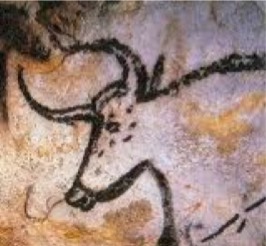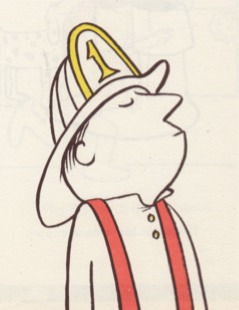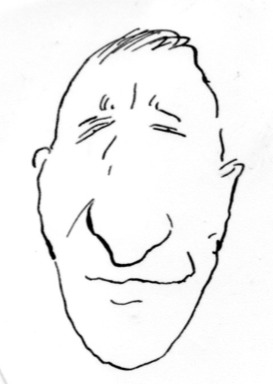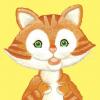MY BLOGS
Nat Blog
July 2011
In order to tell a story Illustrators have to draw the eye to what’s most important in a picture; in most cases this means the characters who are acting out the story. One way to make characters stand out from the background colours is to use an outline. Before I tell you about the further development of the artwork style of Nat the Cat I'd like to take you on a little diversion into the topic of line drawing.
 Line drawing reduces the representation of shade, form, and colour that you see around you to a single line which describes only the outlines of forms. That line is essentially a lie - in real life there are no lines around what you see, there are only the edges of forms and their colours butting up against each other. You can see the birth of line drawing in early cave paintings. There is something beautiful about this form and I think it comes down to the element of simplification: in this example the whole complicated form and bulk of a bison is captured in a few simple scrapes of a lump of charcoal. Here we are, thousands of years later, and we know immediately what that cave man was describing with his line. So in terms of capturing its subject, it can be said to be a successful drawing but because of its simplicity and elegance it is also beautiful.
Line drawing reduces the representation of shade, form, and colour that you see around you to a single line which describes only the outlines of forms. That line is essentially a lie - in real life there are no lines around what you see, there are only the edges of forms and their colours butting up against each other. You can see the birth of line drawing in early cave paintings. There is something beautiful about this form and I think it comes down to the element of simplification: in this example the whole complicated form and bulk of a bison is captured in a few simple scrapes of a lump of charcoal. Here we are, thousands of years later, and we know immediately what that cave man was describing with his line. So in terms of capturing its subject, it can be said to be a successful drawing but because of its simplicity and elegance it is also beautiful.
 I grew up with line drawings in the comics and books I read as a child. This example is from Bennet Cerf’s book of Riddles. It was fairly recently that I re- found this book and as I leafed through it's pages I realised how every line of the drawings were inscribed in my memory. By studying, tracing and copying such illustrations I learnt a visual language which I then developed in my own drawings.
I grew up with line drawings in the comics and books I read as a child. This example is from Bennet Cerf’s book of Riddles. It was fairly recently that I re- found this book and as I leafed through it's pages I realised how every line of the drawings were inscribed in my memory. By studying, tracing and copying such illustrations I learnt a visual language which I then developed in my own drawings.
 Here is an example of one of my drawings from my teenage years which demonstrates the expressiveness which a simple line can bring to a face. The lines above the man’s forehead and the squintyness of his eyes suggest that he is thinking about what he is looking at. The addition of a line to the right of his mouth describes a slight smirk which suggests a wry sense of humour. All this from a few milimetres of ink drawn across a page! Line drawing may be a lie, a simplification of what is seen but, as seen in the Bison drawing, it is a very effective, eloquent and potentially beautiful lie.
Here is an example of one of my drawings from my teenage years which demonstrates the expressiveness which a simple line can bring to a face. The lines above the man’s forehead and the squintyness of his eyes suggest that he is thinking about what he is looking at. The addition of a line to the right of his mouth describes a slight smirk which suggests a wry sense of humour. All this from a few milimetres of ink drawn across a page! Line drawing may be a lie, a simplification of what is seen but, as seen in the Bison drawing, it is a very effective, eloquent and potentially beautiful lie.
You don’t have to use an outline to make characters stand out from the background in an illustration, you can do it by use of light and shade and carefully chosen colours; in some ways this makes a more realistic representation of how we see life around us. Some Dogs Do is painted in this way, there’s not a single outline in the whole book. This approach has its own challenges and advantages but after considering it for Nat I decide that I want to use an outline. But outlines come in all colours, styles and thicknesses, the question is; what type of outline shall I use ?
NEW ON THE SITE
HAVE YOU SEEN?



























